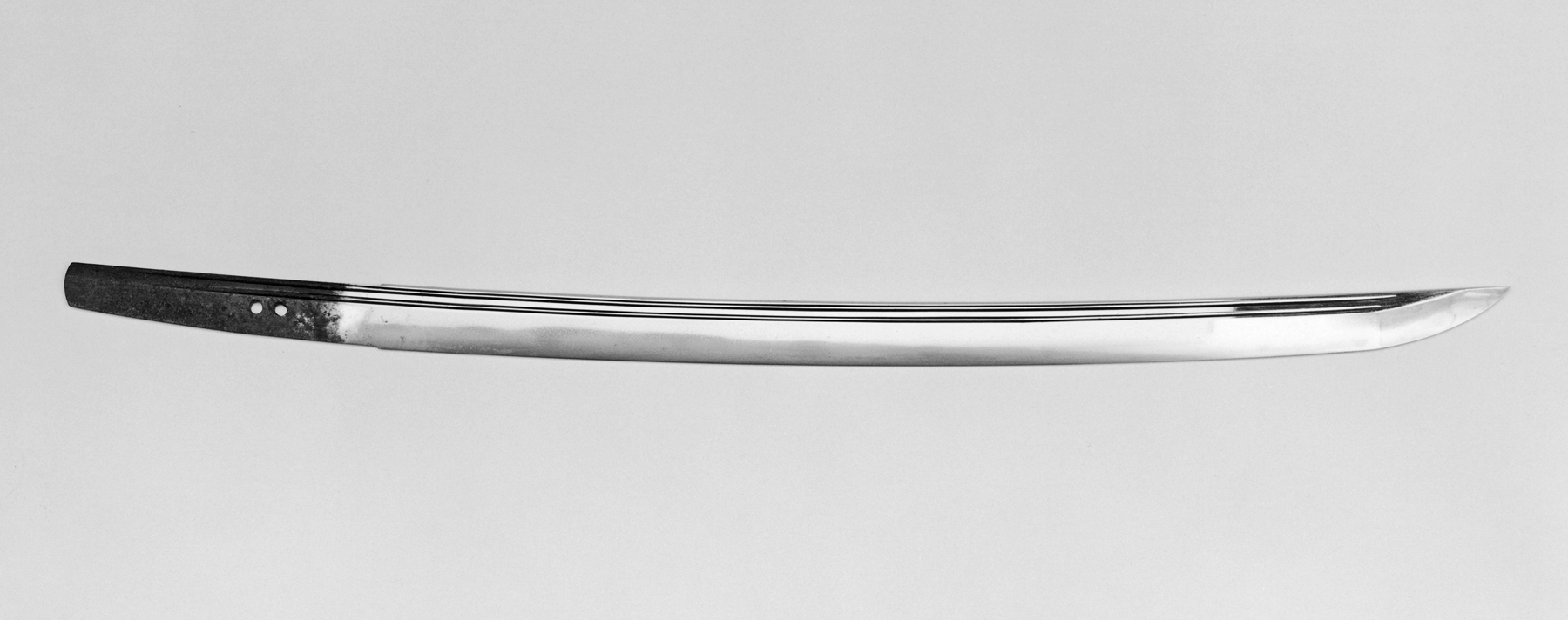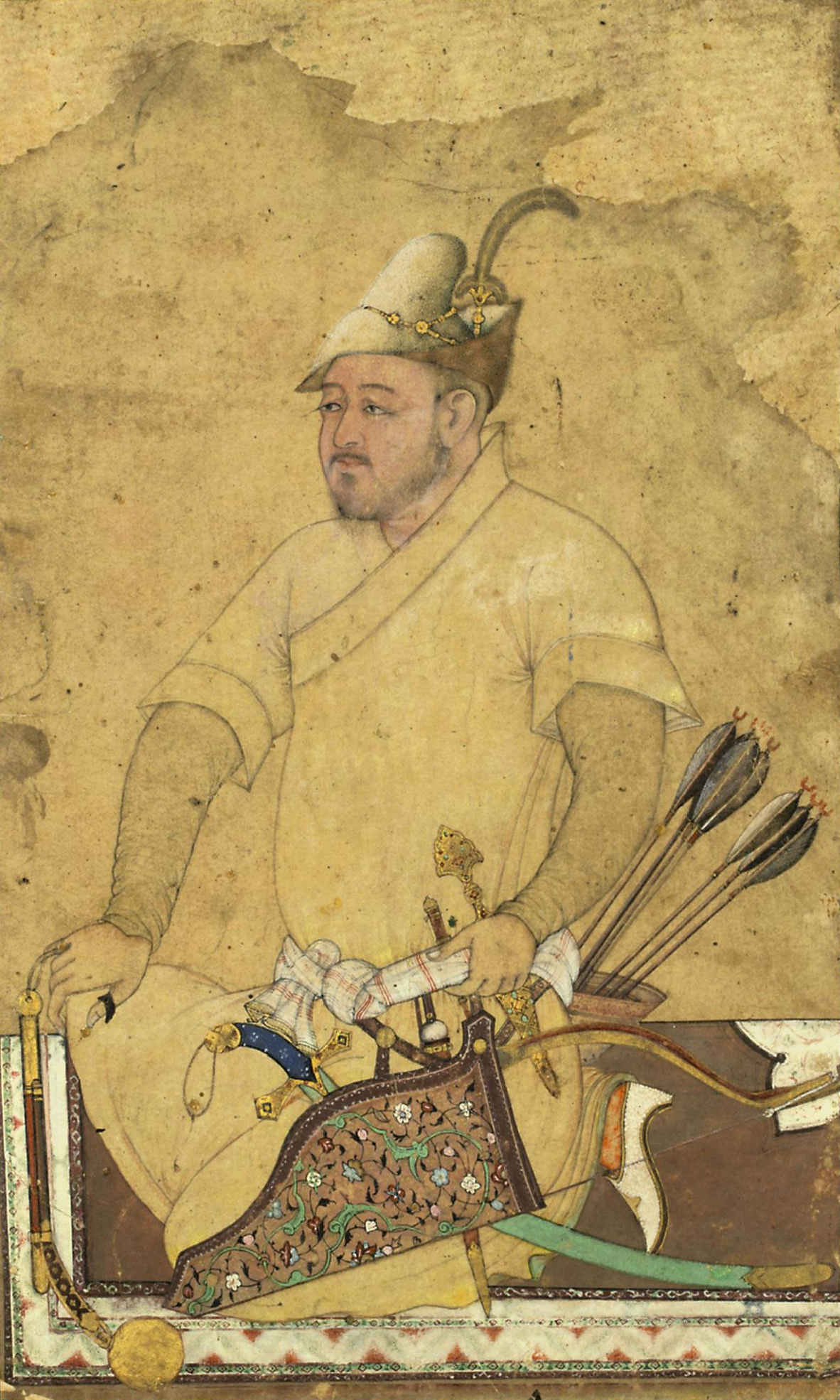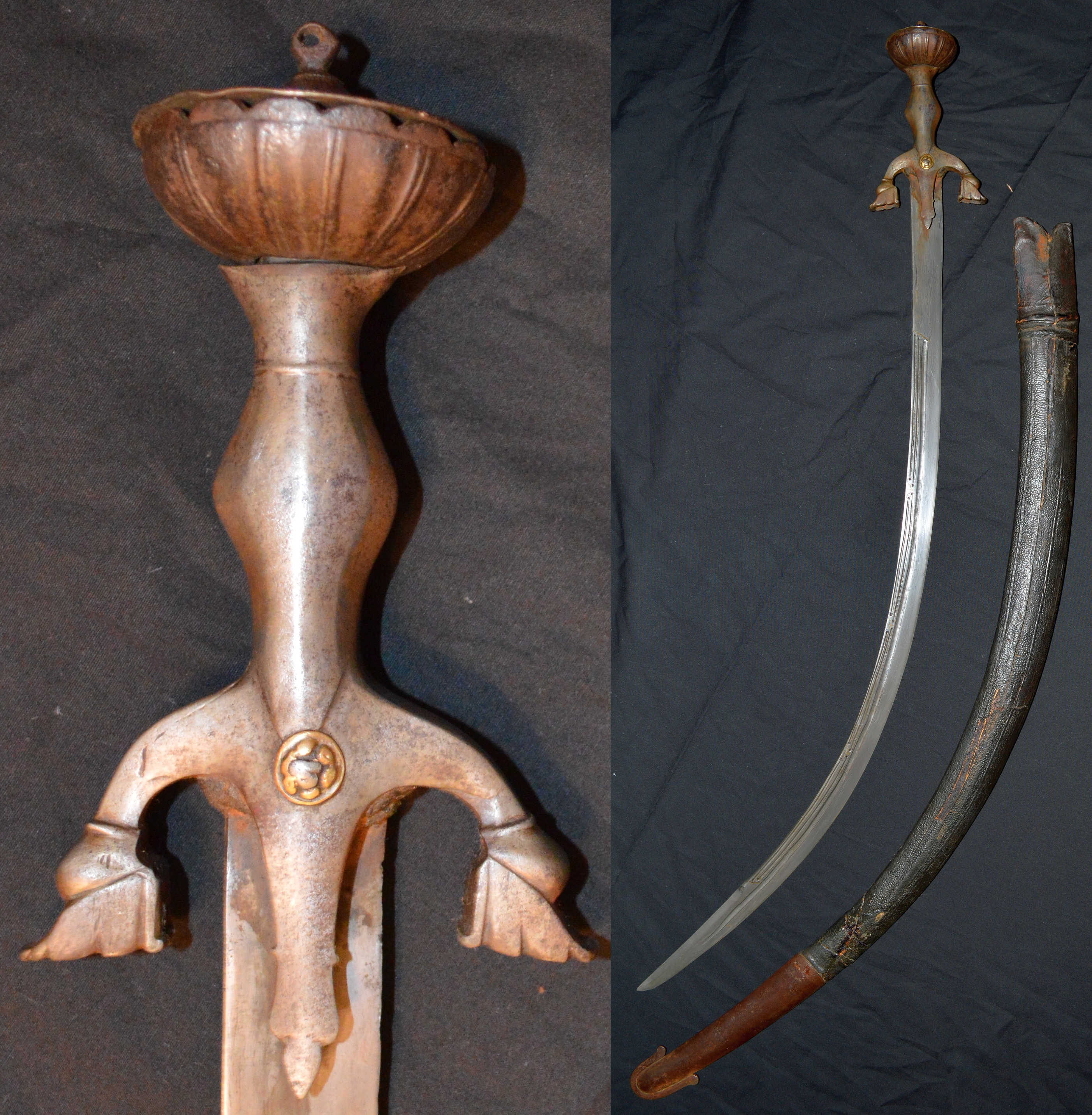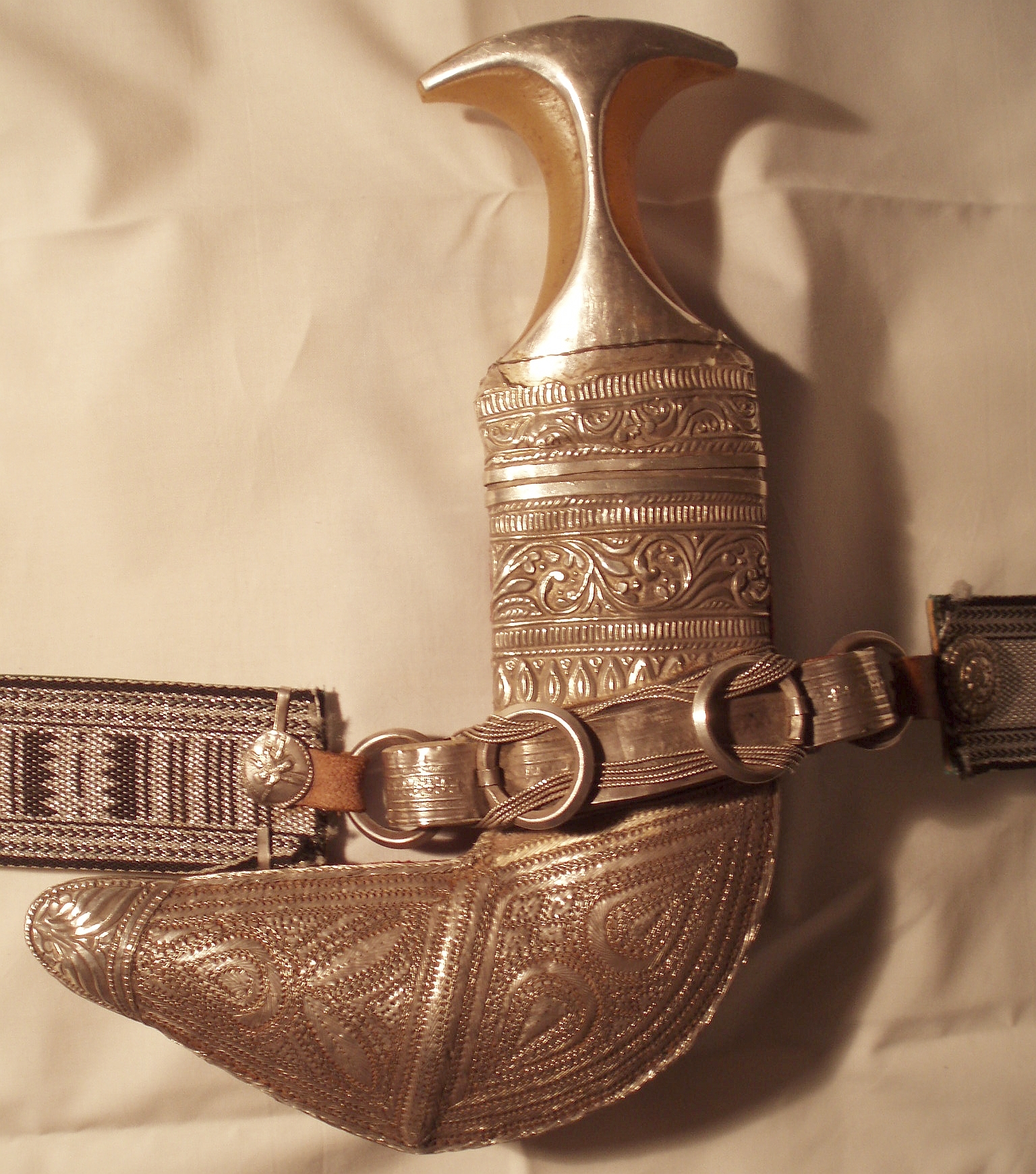|
Qolxad Or Jile (dagger)
The Jile, also known as a Gile in Afar language, in Somali known as Qolxad, is a type of dagger with a long curved blade used by the Somali and Afar people found in Djibouti, Ethiopia, Somalia, and Eritrea. Unique to the Horn of Africa, it is the most famous and characteristic of Afar and Somali daggers. Names The dagger is known as ''Jile'' or ''Gile'' in Afar and ''Qolxad'' in Somali. Overview The jile is a curved dagger ranging in length from 30 to more than 50 cm. The handle is typically made of wood or more rarely from buffalo or rhinoceros horn. The pommel often ends with three teeth of bronze, zinc or silver. The middle tooth is the most prominent. The double-edged blade is shaped like an asymmetrical leaf and today is typically made from salvaged metal, usually iron or steel from broken car and truck springs. The sheath is made of wood wrapped in leather, though it can sometimes have brass plates attached near the handle. The sheath always has an extra long tip, som ... [...More Info...] [...Related Items...] OR: [Wikipedia] [Google] [Baidu] |
Horn Of Africa
The Horn of Africa (HoA), also known as the Somali Peninsula, is a large peninsula and geopolitical region in East Africa.Robert Stock, ''Africa South of the Sahara, Second Edition: A Geographical Interpretation'', (The Guilford Press; 2004), p. 26 Located on the easternmost part of the African mainland, it is the fourth largest peninsula in the world. It is composed of Ethiopia, Eritrea, Somalia and Djibouti; broader definitions also include parts or all of Kenya, Sudan, South Sudan, and Uganda. The term Greater Horn Region (GHR) can additionally include Burundi, Rwanda, and Tanzania. It lies along the southern boundary of the Red Sea and extends hundreds of kilometres into the Guardafui Channel, Gulf of Aden, and Indian Ocean and shares a maritime border with the Arabian Peninsula of Western Asia. Names This peninsula has been known by various names. Ancient Greeks and Romans referred to it as Regio Aromatica or Regio Cinnamonifora due to the aromatic plants or as Regio I ... [...More Info...] [...Related Items...] OR: [Wikipedia] [Google] [Baidu] |
Blade
A blade is the portion of a tool, weapon, or machine with an edge that is designed to puncture, chop, slice or scrape surfaces or materials. Blades are typically made from materials that are harder than those they are to be used on. Historically, humans have made blades from flaking stones such as flint or obsidian, and from various metal such as copper, bronze and iron. Modern blades are often made of steel or ceramic. Blades are one of humanity's oldest tools, and continue to be used for combat, food preparation, and other purposes. Blades work by concentrating force on the cutting edge. Certain blades, such as those used on bread knives or saws, are serrated, further concentrating force on the point of each tooth. Uses During food preparation, knives are mainly used for slicing, chopping, and piercing. In combat, a blade may be used to slash or puncture, and may also be thrown or otherwise propelled. The function is to sever a nerve, muscle or tendon fibers, or bloo ... [...More Info...] [...Related Items...] OR: [Wikipedia] [Google] [Baidu] |
Billao
A billao ( so, billaawe), also known as a belawa, is a horn-hilted Somali shortsword or long dagger depending on blade length. It served most notably as a close-quarters weapon in the Dervish State, at the turn of the 20th century. Features The billao has a double-edged, leaf-shaped, asymmetrical blade and a three-pronged pommel. One-pronged pommels with the metal tang protruding out from the center of the hilt have been reported. Together, the grip and pommel are 6¾" in circumference. The billao's blade is made of iron or steel, and is 10½" long and 2½" wide. Though other horn types are also used, the handle is typically made from the horn of buffalo. In total, the dagger is 17¼" long. The sheath is made of sheepskin, and the sword is worn on a belt around the waist. It is said to have originated in the Togdheer, Cayn and Sool occupied regions of present-day Somaliland See also *List of swords Lists of swords: *List of historical swords *List of Japanese swords ** Lis ... [...More Info...] [...Related Items...] OR: [Wikipedia] [Google] [Baidu] |
Zulfiqar
Zulfiqar ( ar, ذُو ٱلْفَقَار, Ḏū-l-Faqār, ), also spelled ''Zu al-Faqar'', ''Zulfikar'', ''Dhu al-Faqar'', ''Dhulfaqar'' or ''Dhulfiqar'', is the sword of Ali ibn Abi Talib. Middle Eastern weapons are commonly inscribed with a quote mentioning Zulfiqar, and Middle Eastern swords are at times made with a split tip in reference to the weapon. Name The meaning of the name is uncertain. The word ''ḏhu'' () means "possessor, master", and the idafa construction "possessor of..." is common in Arabic phraseology, such as in ''Dhu al-Qarnayn'', ''Dhu al-Kifl'', ''Dhu al-Qadah'' and ''Dhu al-Hijjah''. The meaning of ''faqār'' (), means "splitter, differentiatior". It is often vocalized as ''fiqār'' instead of ''faqār''; Lane cites authorities preferring ''faqār'' however the vocalization ''fiqār'' still sees more widespread use. The word ''faqār'' has the meaning of "the vertebrae of the back, the bones of the spine, which are set in regular order, one upon ... [...More Info...] [...Related Items...] OR: [Wikipedia] [Google] [Baidu] |
Shamshir
A shamshir ( fa, شمشیر) is a type of Persian/Iranian sword with a radical curve. The name is derived from the Persian word ''shamshīr'', which means "sword". The curved "scimitar" sword family includes the shamshir, kilij, talwar, pulwar and nimcha. A ''shamshir shekargar'' ( fa, شمشیر شکارگر, shamshir-e shekârgar, lit=hunters' sword or hunting sword) is the same as a ''shamshir'', except the blade is engraved and decorated, usually with hunting scenes. Description Originally, Persian swords were straight and double edged. Curved Turko-Mongol sabers, sabre blades were Central Asian in origin. There is considerable disagreement between historians as to when these curved blades were first introduced from Central Asia into Iran, Persia, and over what period they became adopted and modified into the recognizable Shamshir. Curved blades began to appear in Persia in the 9th century, when these weapons were used by soldiers in the Greater Khorasan, Khorasan region of ... [...More Info...] [...Related Items...] OR: [Wikipedia] [Google] [Baidu] |
Pulwar
The pulwar or pulouar is a single-handed curved sword originating in Afghanistan. Origin The pulwar originated alongside other scimitar-type weapons such as the Arab saif, the Persian shamshir, the Turkish kilij, and the Indian talwar, all of them ultimately based on earlier Central Asian swords. Originally, the Khyber Knife (a type of short sword) served as the weapon of the common people while upper-classes could afford to import swords from neighbouring Persia and India. Over time, the Afghans combined characteristics of the imported swords and adapted it to create the pulwar. Most existing pulwars date back to the early 19th century. Characteristics Borrowing features from the swords of neighboring lands, the pulwar may be described as an Afghan version of the Indian talwar. Pulwar blades tend to be more elaborately fullered than those of the talwar. Some pulwar hilts were fitted to Persian blades which are slimmer and more curved and tapered towards the tip than the more t ... [...More Info...] [...Related Items...] OR: [Wikipedia] [Google] [Baidu] |
Khanjar
A ''khanjar'' ( ar, خنجر, ku, Xencer, bn, খঞ্জর, khôñjôr tr, Hançer, fa, خنجر, ur, خنجر, sh, Handžar) is a traditional dagger originating from Oman, although it has since spread to the rest of the Middle East, South Asia, and the Balkans. Worn by men for ceremonial occasions, it is a short curved sword shaped like the letter "J" and resembles a hook. It can be made from a variety of different materials, depending on the quality of its craftsmanship. It is a popular souvenir among tourists and is sold in souqs throughout the region. A national symbol of the sultanate, the ''khanjar'' is featured on Oman's national emblem and on the Omani rial. It also features in logos and commercial imagery by companies based in Oman. History Although it is not known when the Omani ''khanjar'' was first created, rock carvings epitomizing the dagger were found on gravestones located in the central part of the Ru’us al Jibal region. These are believed to ... [...More Info...] [...Related Items...] OR: [Wikipedia] [Google] [Baidu] |
Keris
The kris, or ''keris'' in the Indonesian language, is an asymmetrical dagger with distinctive blade-patterning achieved through alternating laminations of iron and nickelous iron (''pamor''). Of Javanese origin, the kris is famous for its distinctive wavy blade, although many have straight blades as well, and is one of the weapons commonly used in the '' pencak silat'' martial art native to Indonesia. A kris can be divided into three parts: blade ( or ), hilt (), and sheath (). Each part of the kris is considered a piece of art, often carved in meticulous detail and made from various materials: metal, precious or rare types of wood, or gold or ivory. A kris's aesthetic value covers the (the form and design of the blade, with around 60 variants), the (the pattern of metal alloy decoration on the blade, with around 250 variants), and referring to the age and origin of a kris. Depending on the quality and historical value of the kris, it can fetch thousands of dollars or more. ... [...More Info...] [...Related Items...] OR: [Wikipedia] [Google] [Baidu] |
Janbiya
A jambiya, also spelled janbiya, jambya, jambia and janbia ( ar, جنۢبية ''janbīyah''), is a specific type of dagger with a short curved blade with a medial ridge that originated from the Hadhramaut region of Yemen. They have spread all over the Middle East as well as South Asia and Southeast Asia. Men typically above the age of 14 wear it as an accessory to their clothing. Types The jambiya were taken by travelers to other cultures including the Ottoman Empire, Persia and India, where they were adopted with slight differences to the blade, hilt and scabbard. Hilt or handle A significant part of a jambiya is its hilt (handle). The ''saifani'' hilt is made of rhinoceros horn, which can cost up to $1500 per kilogram. It is used on the daggers of wealthier citizens. Different versions of ''saifani'' hilts can be distinguished by their colour. Other janbiya hilts are made of a different types of horn, wood, metal and ivory from elephants and walrus. Apart from the material ... [...More Info...] [...Related Items...] OR: [Wikipedia] [Google] [Baidu] |
Firangi (sword)
The firangi (; derived from the Arabic term (al- faranji) for a Western European Frank"]) (Marathi language, Marathi:फिरंगाना) was an Indian sword type which used blades manufactured in Western Europe, particularly Solingen, and imported by the Portuguese, or made locally in imitation of European blades.Stone and LaRocca, p. 229 Physical characteristics The firangi sword characteristically had a long, , straight blade of either broadsword (two edged) or, more commonly, backsword (single edged) form. The blade often incorporated one, two, or three fullers (grooves) and had a spear-tip shaped point. The sword could be used to both cut and thrust. Examples with narrow rapier blades have survived, though in small numbers. The hilt was of the type sometimes called the "Indian basket-hilt" and was identical to that of another Indian straight-bladed sword the khanda. The hilt afforded a substantial amount of protection for the hand and had a prominent spike projecting fro ... [...More Info...] [...Related Items...] OR: [Wikipedia] [Google] [Baidu] |
Blacksmiths
A blacksmith is a metalsmith who creates objects primarily from wrought iron or steel, but sometimes from other metals, by forging the metal, using tools to hammer, bend, and cut (cf. tinsmith). Blacksmiths produce objects such as gates, grilles, railings, light fixtures, furniture, sculpture, tools, agricultural implements, decorative and religious items, cooking utensils, and weapons. There was an historical distinction between the heavy work of the blacksmith and the more delicate operation of a whitesmith, who usually worked in gold, silver, pewter, or the finishing steps of fine steel. The place where a blacksmith works is called variously a smithy, a forge or a blacksmith's shop. While there are many people who work with metal such as farriers, wheelwrights, and armorers, in former times the blacksmith had a general knowledge of how to make and repair many things, from the most complex of weapons and armor to simple things like nails or lengths of chain. Etymology The " ... [...More Info...] [...Related Items...] OR: [Wikipedia] [Google] [Baidu] |
Self-defense
Self-defense (self-defence primarily in Commonwealth English) is a countermeasure that involves defending the health and well-being of oneself from harm. The use of the right of self-defense as a legal justification for the use of force in times of danger is available in many jurisdictions. Physical Physical self-defense is the use of physical force to counter an immediate threat of violence. Such force can be either armed or unarmed. In either case, the chances of success depend on various parameters, related to the severity of the threat on one hand, but also on the mental and physical preparedness of the defender. Unarmed Many styles of martial arts are practiced for self-defense or include self-defense techniques. Some styles train primarily for self-defense, while other combat sports can be effectively applied for self-defense. Some martial arts train how to escape from a knife or gun situation or how to break away from a punch, while others train how to attack. To ... [...More Info...] [...Related Items...] OR: [Wikipedia] [Google] [Baidu] |







